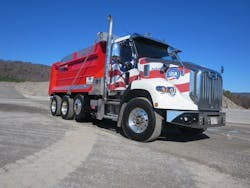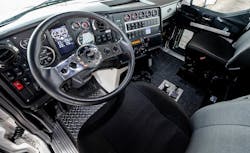Autocar Earns 'Badass' Moniker
This truck is Badass. Really, that’s the name trademarked by Autocar LLC. Just sitting still it looks “tough” and “uncompromising,” as dictionaries define the slang term. Though the word can also mean “intimidating” and “hard to get along with,” this DC-64D heavy truck, its more polite designation, drove rather agreeably near its birthplace in the deep South, on a sunny day just before Christmas. The dumper is the third iteration of Autocar’s 1-year-old conventional-cab vocational series. It was preceded by M for mixer and R for refuse models, which differ in frame, wheelbase, and suspension configurations. And it will be followed by other versions as the builder gradually expands its severe-service lineup.
This dump truck is a demonstrator and one of the few the company has assembled for stock. Autocar builds each truck to order for a specific buyer, and every truck on the line is sold before it goes out the door, according to Tim Thornton, VP and general manager. Autocar has a service dealer network, in addition to direct OEM support from Autocar Solutions. Customers can deal directly with the factory, both for sales and product support. Representatives will travel to set up customers and any truck shops they pick to do warranty and repair work. Support continues 24/7 throughout a truck’s life, for the first and subsequent owners. Customers pay for post-warranty parts, but all consultations by phone and video come at no charge. As with other truck makers, Autocar currently has a healthy backlog of orders but unlike them, it stayed open during the Covid scourge of 2020 and ’21, Thornton said.
This 12-wheel “tri-axe” demo truck, a 6x4 with a steerable lift axle, is typical of what the company has been selling into the dump market, said Bruce Mochrie, a business development specialist who was my guide this day. It had Cummins power, an Allison transmission, Spicer driveline, and Meritor axles—popular names producing reliable components. Its Cummins X12 is the largest diesel available in the DC series; the smaller L9 is an option, as are natural gas-fueled versions of those engines. At about 2,250 pounds dry, the X12 is the lightest engine in its class, but makes up to 500 horsepower, which was the rating in this truck.
So far, most Autocar sales have been in the Southeast and are spreading to the Northeast. These are regions whose state weight laws favor the DC’s set-back steer axle, Mochrie said. Sometime in 2023 or ’24 Autocar will have an axle-forward version, which will allow sales expansion in bridge-formula states where regulations encourage longer wheelbases with forward-set steer axles. A tractor version with Cummins X15 availability might also come around that time, leading to other vocational applications. Our red-white-and-blue dumper was waiting for Mochrie and me near the end of the production line, following a tour of the 1 million-square-foot, former furniture factory on Route 79 north of Birmingham, Alabama.
Mochrie’s driving plan for this day was a cruise north and east on state highways and a secondary road to a large quarry, where we would pick up a load and take it back to the plant. There he would later spread it into large potholes on a gravel lot. That was a run of about 50 miles, during which I got a feel for the truck’s ride and performance empty and loaded. Steering was solid with a surprisingly small turning circle; to take advantage of that I’d probably install a spinner knob, I told him.
Business-like cab interior (above) includes fabric-covered air-ride seats, old-school switch and control layout, and sport-type steering wheel free of buttons. Outward view is very good, especially to the right-front and sides, and to the rear. Smart Dash has a large color screen between the speedo and tach for displaying many gauges, numbers, and warning lights.
The truck rode well both ways, with little bouncing or jouncing because the taperleaf front and mechanical rear suspensions were effective at soaking up any irregularities in mostly smooth asphalt pavement, and trails inside the large quarry were well graded. At the quarry, we pulled up to a waiting wheel loader whose operator dropped three big buckets of Number 57 stone into the dump bed. We paused on a scale upon entering and leaving, and the ticket said we had about 23.6 tons aboard, for a gross weight of about 74,000 pounds.
Now the truck got a proper workout and I stood on the accelerator a number of times, particularly during a 3-mile pull up a 6- and 8-percent grade. Road speed dropped from 55 and 60 mph to 35, then 30—about here I switched on the flashers—then to 20 mph as the Cummins kept a-hummin’ at 1,900 to 2,000 rpm. At 20, the 6-speed Allison had gone down to 3rd gear, for this was a serious climb. A line of cars trailed behind, but the motorists appeared patient because loaded dumps are evidently common on these hilly roads leading from the quarry. We topped the hill at about 30 mph and the Allison upshifted quickly and smoothly. On following downgrades, I made frequent use of the Jake Brake, often in Position 3, to keep our speed in check. Service brakes—discs in front and drums in the rear—were reassuringly strong.
Switches on the Autocar’s dashboard were mounted old-school style, most to the driver’s right in a couple of rows. Switches for the Jake and cruise control were close at hand, almost too close, as they were sometimes hidden by the rim of the 18-inch steering wheel, but I got used to them after a while. I was gladdened that the wheel’s spokes had no buttons that required me to drop my eyes off the road to figure them out. A Smart Dash had a large and legible color screen right in front of me. On it a driver or technician can call up a lot of gauges and data, scrolling with a nearby rotary button. Among the permanent electro-mechanical gauges was one for coolant temperature, which never rose above 200 F during that hard upgrade pull, by the way. Mochrie said the engine fan, which I couldn’t hear, stayed at low speed, thanks to effective cooling.
Engineers went to great lengths to design long life and easy maintenance into their Autocars, he said. For instance, air lines are installed after the chassis is painted so their colors remain vivid and easy to trace; electrical lines are wrapped in a robust woven material that is further protected by heat-shielding aluminum wrap near engine exhaust components; the radiator surge tank is rugged stainless steel; and the heater and air conditioning modules, including the blower, are at the passenger’s knees behind an easily removed panel. Above that is the fuse box accessible by popping off a cover. If a fuse blows, a warning appears on that display screen and a diagram shows exactly where the fuse is. The complete service manual, with diagrams, illustrations, and fix-it instructions, can be called up on that screen or loaded onto a tablet or laptop.
Auxiliary equipment, including the dump and lift-axle controls inside the cab, was installed and pre-wired at the factory, and tanks and boxes were positioned to be out of the way for when the upfitter bolted a body aboard. He only had to plug into the chassis wiring system. This leaves little room for error and eliminates the need for cutting into the cab or wiring harness. All this makes an Autocar’s premium price—more than any competing make—a real value, Mochrie said. There’s tradition, too, as Autocar is the oldest nameplate in the North American automotive business, dating to 1899. Badass-ness is far more recent.
Autocar DC-64D Specs
- Truck: 2021 Autocar DC-64D, conventional-cab, 6x4 construction dump chassis with pusher-type lift axle, BBC 112.5 in., wheelbase 210 in., straight frame rails 7/16 in. thick x 11.25 in. high, GVW rating 80,000 lb.
- Engine: Cummins X12, 11.4 liters (697 cu. in.), 500 hp/1695 lb.-ft., EPA 2018 emissions controls, with Jacobs Engine Brake
- Transmission: Allison 6-speed 4500 RDS torque converter full automatic
- Front axle: 20,000-lb. Hendrickson SteerTec NX on Hendrickson taperleafs, w/ Sheppard M100 dual hydraulic power
- Lift axle: 13,500-lb. Hendrickson Composilite EXS, air lift and ride
- Rear axles: 46,000-lb. Meritor RT-46-160 w/ locking diffs, 4.30 ratio, on Hendrickson HMX 460 Haulmaax mechanical rubber-blocks
- Brakes: front, Meritor EX225 air disc; lift, Hendrickson integral 15-x4-in. drum; rear, Meritor Q-Plus 16.5- x 7-in. drum, w/
- Wabco ABS
- Tires, wheels: Bridgestone M870 315/80R22.5 front; M799 11R22.5 rear; R250ED 275/70R22.5 lift, all on Alcoa Dura Bright polished aluminum discs
- Fuel, DEF tanks: 100-gal. polished aluminum, 12-gal. plastic
- Body: R&S Godwin CS series 17-yd.
- steel dump

